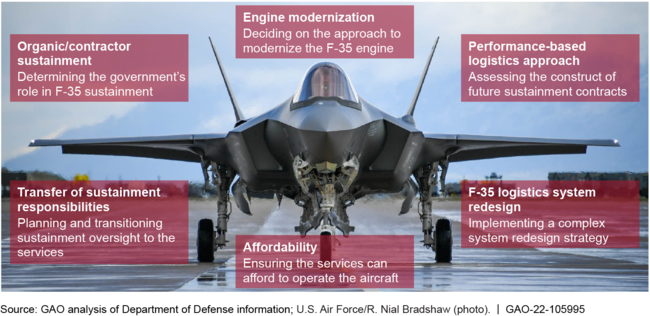F-35 Sustainment: DOD Faces Several Uncertainties and Has Not Met Key Objectives
Fast Facts
F-35 aircraft comprise a growing portion of DOD's aviation fleet. DOD currently has 450 F-35s, and plans to procure about 2,500 in total.
However, we testified that the F-35 fleet's average mission capable rate—the percentage of time during which the F-35s can fly and perform at least one mission—declined between FY 2020 and FY 2021. One major reason is that an increasing number of F-35s have not been able to fly because they don't have a working engine.
We have ongoing work exploring this issue.

Highlights
What GAO Found
The F-35 continues to not meet its targets for mission capable rates—a measure of the readiness of an aircraft fleet—or its reliability and maintainability metrics. For example, the Department of Defense's (DOD) full mission-capable rates—the percentage of time during which the aircraft can perform all of its missions—for the F-35B were below the target by 41 percentage points in fiscal year 2021.
A leading driver of the F-35 not being mission capable has been engine issues, as discussed in GAO's draft report.
F-35 Aircraft without an Operating Engine, January 2020 – February 2022

DOD has begun implementing multiyear plans leading to some improved engine outcomes. The engine sustainment strategy's goal is that no more than 6 percent of F-35 aircraft are unable to operate due to engine issues, which DOD has exceeded since April 2021. However, the military services desire outcomes similar to other fighter aircraft, which since 2016 have generally experienced less than 1 percent being unable to operate due to engine issues. Until the strategy is assessed and updated, the services may be limited in achieving their missions.
GAO's prior and ongoing work show that DOD also faces many uncertainties as it decides the future of F-35 sustainment.
Uncertainties Shaping the Future of F-35 Sustainment

Why GAO Did This Study
The F-35 aircraft with its advanced capabilities, represents a growing portion of DOD's tactical aviation fleet. DOD plans to procure nearly 2,500 F-35s with an estimated $1.3 trillion in life-cycle costs associated with operating and sustaining the aircraft.
This statement provides (1) the status of the F-35 program's ability to meet key sustainment metrics, (2) DOD's current engine sustainment strategy, and (3) uncertainties facing F-35 sustainment. This statement is based on GAO's body of work issued from 2014 through 2022, draft report on F-35 engine sustainment that was provided to DOD this month for review and comment, and ongoing review of F-35 maintenance.
GAO analyzed key metrics for fiscal years 2019-2022, reviewed F-35 strategy and program documents, and interviewed officials. As a part of on-going work, from December 2021 through March 2022, GAO staff visited two depot maintenance facilities and three installations that are the home stations for F-35 squadrons.
Recommendations
In its draft report, GAO is recommending, among other things, that DOD assess and update the F-35 engine sustainment strategy, including its goals and actions to achieve its goals. GAO's prior reports since 2014 have made several recommendations to enhance F-35 sustainment, some of which remain unimplemented as discussed in the testimony.
